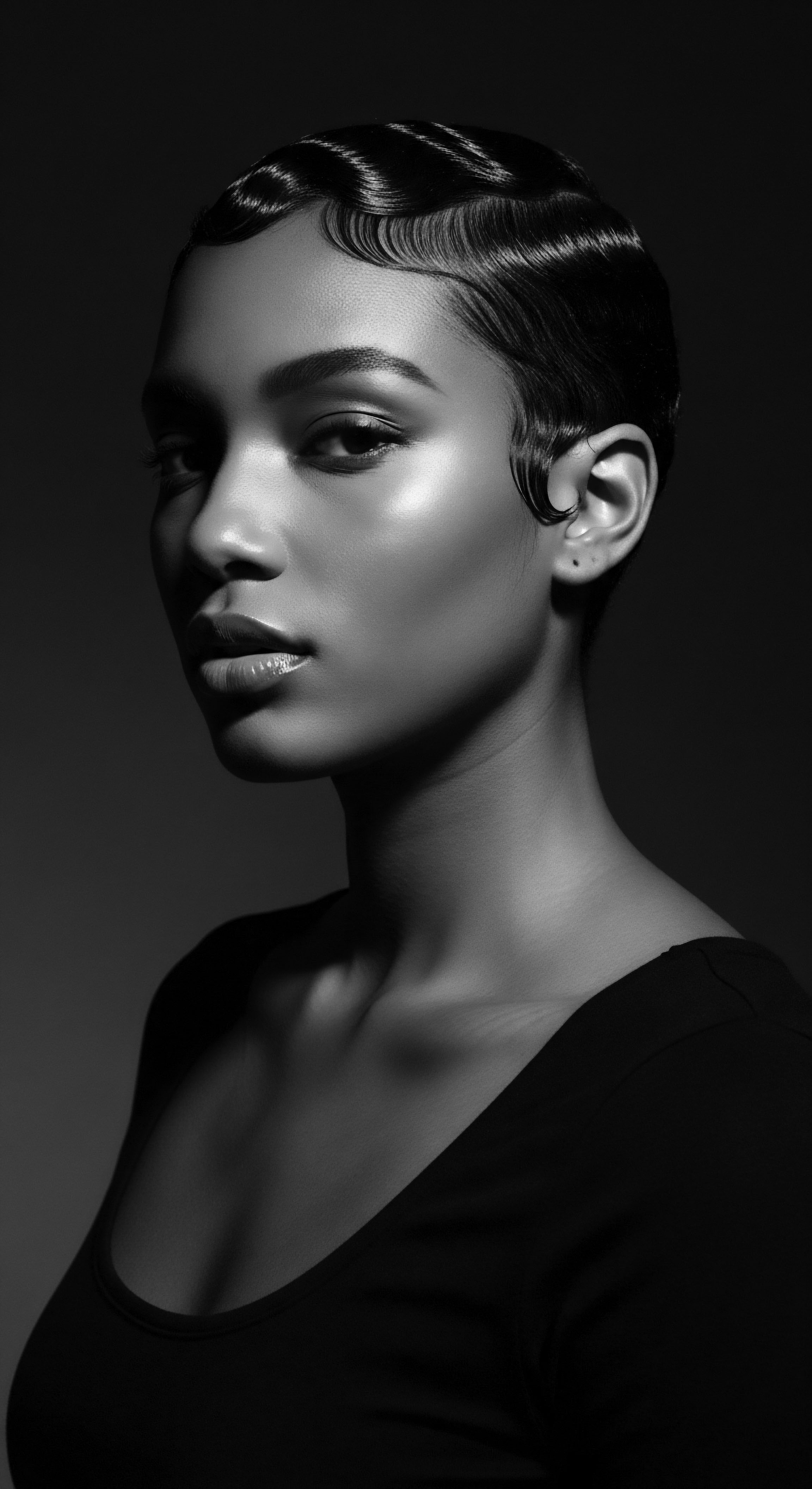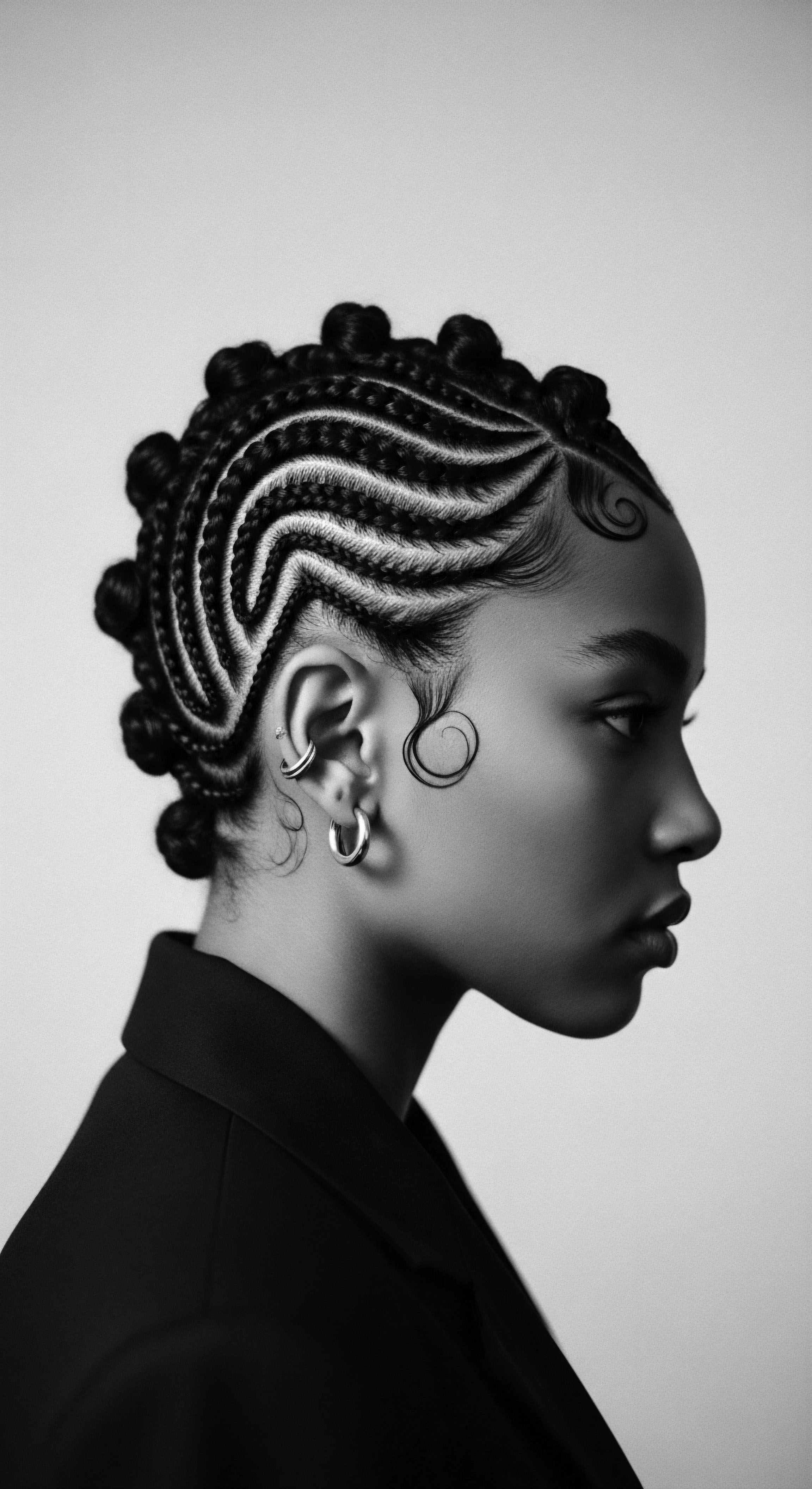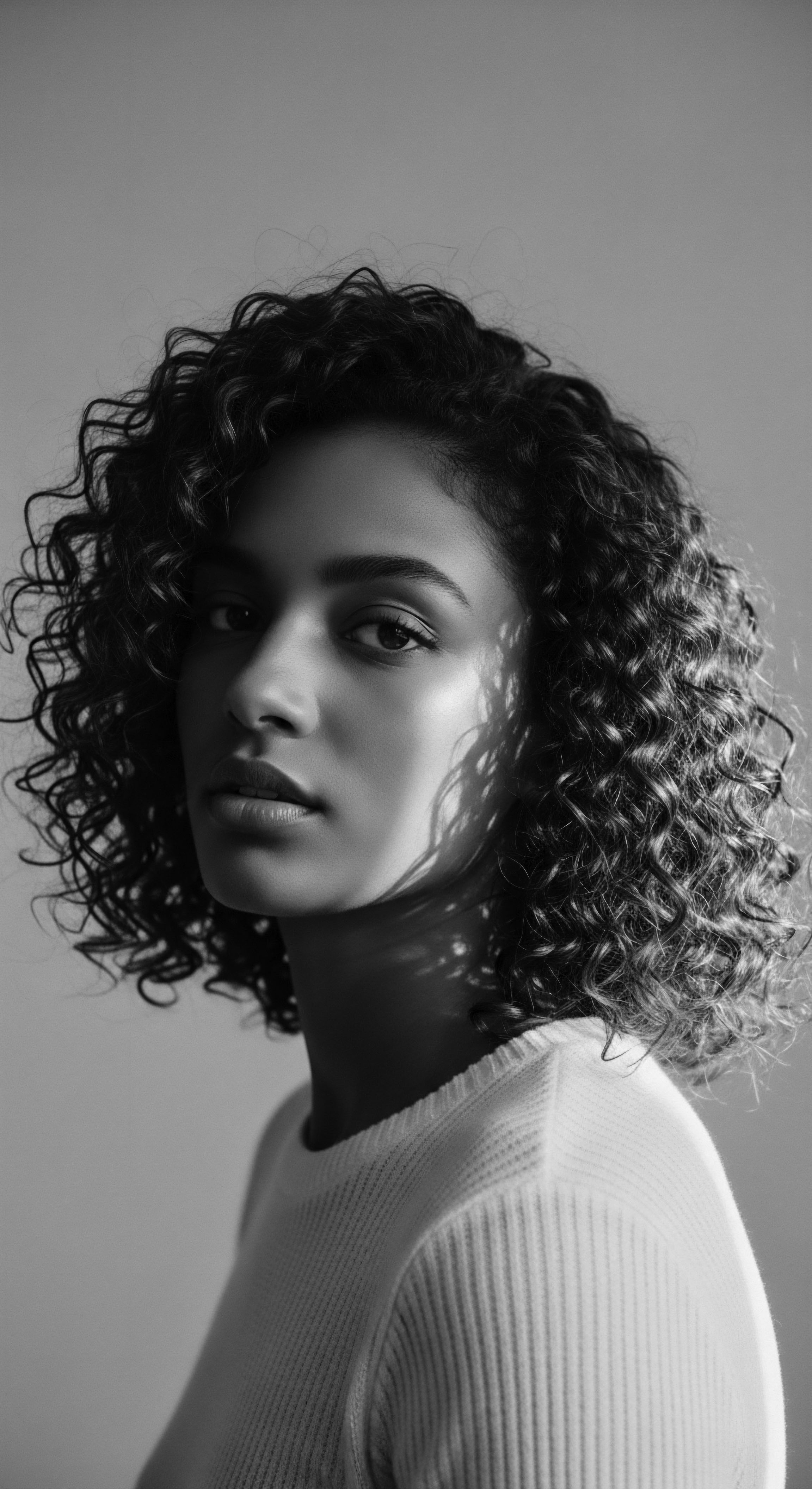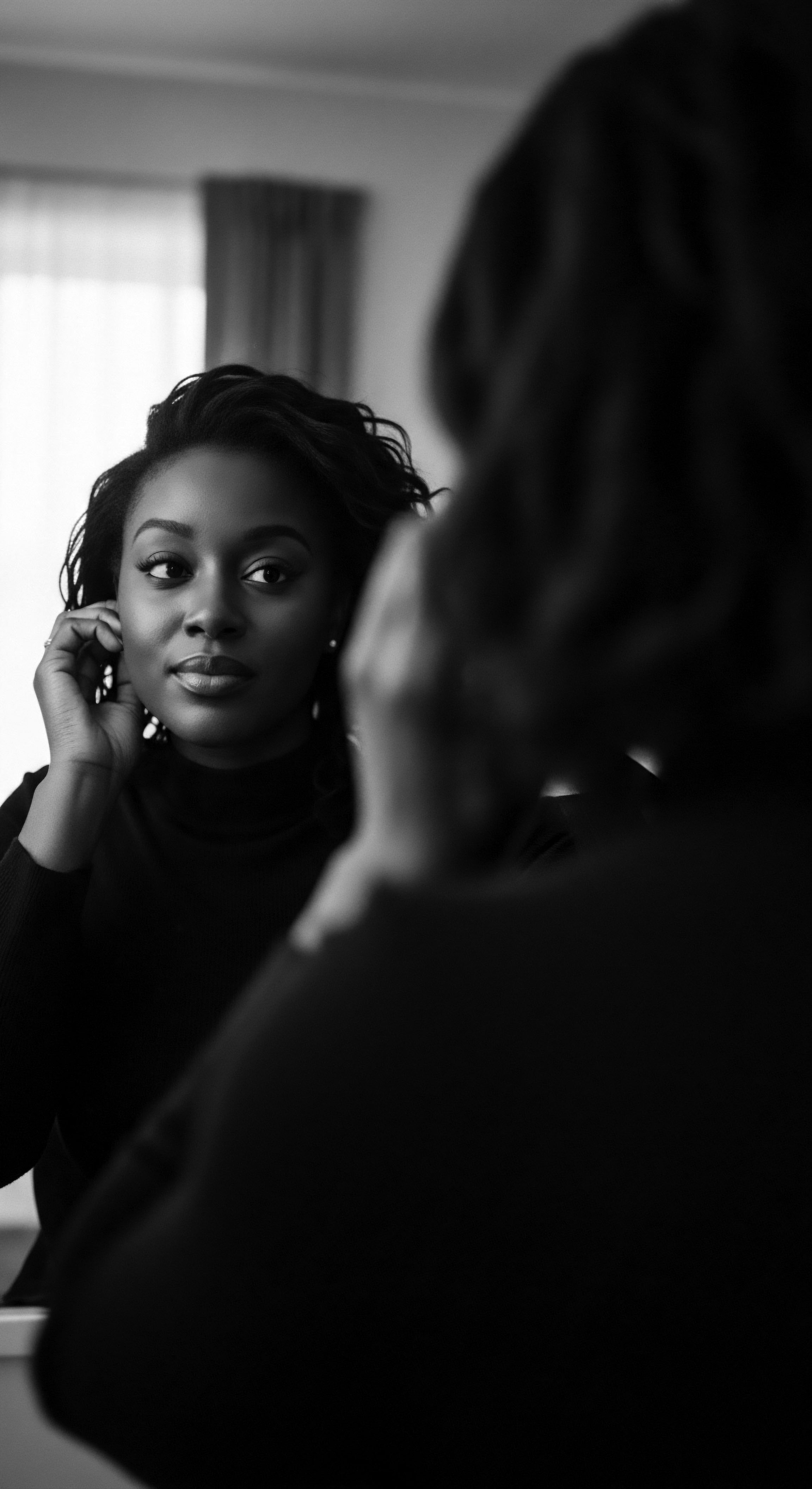
Roots
There exists a whisper that traces through every strand, a story held within the very helix of textured hair. It is a story of resilience, of beauty forged in sun-drenched landscapes and resilient spirits, and yes, it is also a story that speaks to an inherent truth ❉ textured hair, with its coils and curls, tends to lose moisture with a speed that often surprises those unfamiliar with its profound heritage. This phenomenon is not a fault; it is an echo from the source, a biological signature shaped by millennia of adaptation and a testament to the ancestral ingenuity that learned to harmonize with its rhythms. To truly grasp why this is so, we must look not just at the immediate science, but at the deep wellspring of its past, understanding hair as a living archive of identity and tradition.

What Makes Textured Hair Unique?
The secret, if one can call it that, lies in the very architecture of the hair strand itself. Unlike straight hair, which typically emerges from a round follicle and possesses a more uniform, cylindrical shape, textured hair—particularly that of African and mixed-race ancestries—springs from an elliptical, often curved, follicle. This curvature causes the hair shaft to grow in a spiral or helical pattern. Each twist and turn, each bend in the strand, creates points of structural variation.
Think of it not as a smooth, unbroken highway, but as a winding path with many curves and turns. These structural characteristics are not random; they are deeply ingrained, a part of the biological blueprint passed down through generations.

The Anatomy of a Strand
At its heart, hair is composed primarily of keratin, a protein. This protein forms three main layers ❉ the medulla, the cortex, and the cuticle. The outermost layer, the Cuticle, is composed of overlapping, scale-like cells, much like shingles on a roof. These scales lay flat on straight hair, creating a relatively smooth surface that minimizes friction and allows for efficient light reflection and moisture retention.
On textured hair, however, the very curvature of the strand means these cuticle scales often do not lie as flat. They can be naturally more raised or prone to lifting at the many points where the hair bends.
This subtle, yet significant, difference in cuticle alignment plays a central role in how moisture behaves within textured hair. When the cuticles are even slightly lifted, they create microscopic avenues through which water molecules can escape more readily. It becomes a less sealed environment, allowing moisture to evaporate from the inner cortex at a faster pace.
This inherent openness, a direct consequence of the hair’s unique curl pattern, makes textured hair more susceptible to dryness. It is a biological reality that has always shaped the care practices of those who wear it.
Textured hair’s inherent architecture, shaped by its curved follicles and intricate curl patterns, naturally creates more opportunities for moisture to escape.

Ancestral Adaptations to Moisture Loss
From the earliest human settlements on the African continent, communities observed and understood the nature of their hair. They recognized its tendency towards dryness, especially in harsh, arid climates or during dry seasons. This observation was not a source of frustration but a catalyst for ingenuity.
Their care practices were not born of modern scientific understanding of cuticle layers, but from deep, empirical knowledge passed across generations. They knew what worked to keep hair supple and healthy, often through direct interaction with their environment and a profound connection to the land and its offerings.
Ancient civilizations developed sophisticated methods and used natural resources to address this thirst. They learned to seal moisture, protect strands from environmental stressors, and maintain hair health long before the advent of modern cosmetic chemistry. This ancestral wisdom forms the bedrock of textured hair care today.
Consider the traditional use of shea butter, a staple across West Africa for centuries. Collected from the nuts of the shea tree, its rich, emollient properties made it a cherished ingredient for skin and hair. Communities discovered that applying this butter, often warmed and softened, to the hair provided a protective coating, a natural barrier against moisture evaporation.
This practice was not simply about beauty; it was about survival and maintaining wellness in challenging conditions. The very act of applying these traditional butters and oils became a ritual, a communal activity shared between mothers, daughters, and friends, reinforcing bonds and preserving cultural identity.
| Hair Type Feature Follicle Shape |
| Textured Hair (African/Mixed-Race Ancestry) Elliptical, curved, often spiral |
| Straight Hair (European/Asian Ancestry) Round, generally symmetrical |
| Hair Type Feature Hair Shaft Shape |
| Textured Hair (African/Mixed-Race Ancestry) Flat or elliptical, with twists and turns |
| Straight Hair (European/Asian Ancestry) Circular or oval, uniform |
| Hair Type Feature Cuticle Layer Adherence |
| Textured Hair (African/Mixed-Race Ancestry) Often raised at points of curvature, more susceptible to lifting |
| Straight Hair (European/Asian Ancestry) Generally lies flat, creating a smoother surface |
| Hair Type Feature Surface Area |
| Textured Hair (African/Mixed-Race Ancestry) Increased surface area due to coiling, leading to higher exposure to air |
| Straight Hair (European/Asian Ancestry) Lower surface area, less exposure to air |
| Hair Type Feature Water Permeability |
| Textured Hair (African/Mixed-Race Ancestry) Higher diffusion coefficient, lower permeability to water compared to European hair |
| Straight Hair (European/Asian Ancestry) Lower diffusion coefficient, higher permeability to water, higher hydration levels |
| Hair Type Feature Moisture Loss Tendency |
| Textured Hair (African/Mixed-Race Ancestry) Rapid evaporation due to open cuticle and increased surface area |
| Straight Hair (European/Asian Ancestry) Slower evaporation, better retention due to flat cuticle |
| Hair Type Feature This table highlights key differences in hair structure, influencing how moisture is retained and lost, a knowledge deeply rooted in ancestral observation and modern science. |

Ritual
The practices surrounding textured hair care are not simply a series of steps; they are rituals, deeply woven into the fabric of daily life and communal identity. These rituals, often passed down through matriarchal lines, emerged from a profound understanding of the hair’s needs, particularly its thirst. They represent generations of intuitive science, a collective wisdom that recognized the intrinsic connection between hair health, personal wellbeing, and cultural belonging. The rhythmic application of oils, the patient detangling, the intricate braiding — each act a testament to a heritage that prioritized moisture, protection, and the celebration of unique textures.

How Do Ancestral Practices Address Moisture Loss?
Long before laboratories isolated specific chemical compounds, traditional cultures employed ingredients and techniques that directly countered the hair’s tendency to dry quickly. Their approach was holistic, considering not just the hair strand, but the scalp, the climate, and the overall health of the individual. This comprehensive viewpoint guided the creation of practices that preserved moisture and sustained hair health through changing seasons and varied environments.

The Significance of Oils and Butters
Across the African continent and throughout the diaspora, plant-based oils and butters have held a sacred place in hair care. These natural emollients provided the vital barrier needed to seal in hydration. They were the original conditioners and moisturizers, meticulously applied to thirsty strands.
The wisdom behind their use spoke to a deep knowledge of their properties ❉ some oils, lighter, might soften, while heavier butters created a lasting seal. This practical application became a central component of moisture retention strategies.
- Shea Butter ❉ From the shea tree, a source of rich fatty acids, offering substantial moisture and a protective layer.
- Coconut Oil ❉ A pervasive ingredient, valued for its ability to penetrate the hair shaft and reduce protein loss, assisting with moisture retention.
- Castor Oil ❉ Particularly Jamaican black castor oil, prized for its thick consistency, excellent for sealing moisture, especially at hair ends.
- Chebe Powder ❉ Originating from Chad, this powder, made from various plant ingredients, is known to help increase hair thickness and retain moisture.
The application methods themselves were deliberate. Often, these precious ingredients were warmed gently, allowing them to spread more easily and absorb into the hair. This act was often communal, with women gathering to care for each other’s hair, sharing stories and strengthening bonds as they nourished strands. This intergenerational transmission of knowledge ensured that practices for maintaining hair moisture persisted through time, even amidst immense historical disruptions.
The communal care rituals surrounding textured hair, from ancient anointing with natural butters to modern “wash days,” are deeply rooted in ancestral wisdom and collective acts of preserving moisture and identity.

Protective Styles ❉ A Heritage of Shielding
The practice of protective styling in textured hair is not a modern invention; it is a legacy passed down through centuries. These styles, such as braids, twists, and bantu knots, served a fundamental purpose ❉ to shield the hair from the elements, minimize manipulation, and thereby reduce moisture loss and breakage. In climates where sun exposure was constant and dust prevalent, keeping hair gathered and protected was not just aesthetically pleasing but essential for its health and longevity.
Bantu Knots, for instance, a traditional African hairstyle consisting of twisted knots across the scalp, can be traced to the Bantu ethnic groups of Southern Africa. Beyond their symbolic meaning in rituals and as markers of social status, these knotted styles helped keep hair tidy and moisturized in hot, humid climates. They protected fragile hair ends from breakage, making Bantu knots an early forerunner of modern protective styling. As the transatlantic slave trade forcibly dispersed Africans, the Bantu knot tradition crossed the ocean, allowing enslaved women to maintain cultural identity and express pride in their hair textures.
The deliberate choice of these styles demonstrates a deep, intuitive understanding of hair mechanics and environmental interaction. By tucking away the more vulnerable hair ends and reducing friction, these methods inherently slowed down the rate at which moisture could evaporate from the hair shaft. This practical ingenuity, born of necessity and tradition, continues to guide textured hair care today. The echoes of these ancient practices resonate in contemporary routines, where protective styles remain a cornerstone for moisture retention and hair growth.

Relay
The journey of understanding textured hair’s moisture dynamics continues, carrying the torch from ancient wisdom to contemporary scientific inquiry. Modern research, armed with advanced tools, now provides a deeper scientific grounding for phenomena long observed and managed by those with textured hair. This scholarly lens not only validates ancestral practices but also illuminates the subtle interplay of molecular structures and environmental factors that contribute to why these coils and curls appear to shed their hydration with such notable speed. The continuity from empirical knowledge to laboratory findings represents a powerful relay of understanding, affirming the deep insights passed down through generations.

How Does Hair Porosity Affect Moisture Retention?
One of the central concepts explaining textured hair’s moisture behavior is Porosity. Hair porosity refers to the hair’s ability to absorb and retain moisture. It is determined by the condition of the cuticle layer.
When the cuticle scales are tightly bound and lie flat, the hair has low porosity, making it more challenging for moisture to enter but also harder for it to escape. Conversely, when cuticle scales are raised or lifted, the hair exhibits high porosity, allowing water to enter easily but also to exit just as readily.
Textured hair, particularly those with tighter curl patterns, often presents with a naturally higher porosity. This is a direct consequence of the hair shaft’s elliptical shape and multiple points of curvature. At each bend and twist, the cuticle layers are predisposed to be slightly raised.
This means that while textured hair can rapidly absorb water, it struggles to hold onto that hydration for extended periods. It is akin to a beautifully constructed, winding river that has many small tributaries and open banks; water flows in, but it also finds many routes to flow out and evaporate.
A study published in the Journal of Cosmetic Science by Franbourg et al. (2008) observed that African hair exhibited less radial swelling when exposed to water compared to Asian or European hair. While not directly measuring moisture loss, this finding, alongside subsequent lipid analysis in later research, points to differences in internal lipid distribution and permeability that affect how water interacts with the fiber.
African hair, despite sometimes having a higher overall lipid content, particularly apolar lipids, has lipids that are more disordered within its structure compared to Caucasian hair. This disordered lipid arrangement can contribute to higher water diffusion rates, thus explaining why moisture may leave the hair fiber more quickly even when external lipids are abundant.

What Role Does Hair Curvature Play in Moisture Dynamics?
The distinct curvature of textured hair, from the spiral follicle to the helical path of the strand, is a primary determinant of its moisture handling. This structural characteristic contributes to dryness through several interconnected mechanisms.
- Increased Surface Area ❉ The coils and kinks of textured hair naturally create a larger surface area compared to straight hair of the same length. A greater surface area means more exposure to the surrounding air, leading to a higher rate of water evaporation.
- Mechanical Weakness and Breakage Points ❉ The points where the hair bends acutely are areas of structural weakness. These bends make the hair more prone to tangling and breakage, especially when dry. Each instance of breakage, even microscopic, compromises the cuticle further, creating more opportunities for moisture to escape. Research confirms African hair is more fragile and prone to breakage, which contributes to its dryness.
- Uneven Sebum Distribution ❉ The natural oils (sebum) produced by the scalp’s sebaceous glands are meant to coat and protect the hair strand, acting as a natural moisturizer and sealant. On straight hair, sebum can travel down the shaft relatively easily. However, on coily or kinky hair, the twists and turns impede the smooth distribution of sebum from the scalp to the ends. This often leaves the hair ends, which are the oldest and most vulnerable parts of the strand, with less natural protection, exacerbating moisture loss.
These biomechanical characteristics are not deficiencies but evolutionary adaptations. The densely coiled hair of many African populations likely offered protection from intense UV radiation and provided insulation in varied climates. (Caldararo, 2019).
The challenge, then, becomes understanding how to support these unique traits in a way that minimizes moisture loss and celebrates the hair’s inherent strength. This requires a dialogue between ancestral wisdom and modern scientific insight, a conversation that reveals the elegance of traditions that instinctively countered these biological realities.

Do Environmental Factors Affect Hair Moisture?
Indeed, the environment plays a significant part in the moisture story of textured hair. Humidity levels, temperature, and even atmospheric pressure influence how quickly water evaporates from hair strands. For individuals with textured hair, living in drier climates can exacerbate their hair’s natural tendency towards moisture loss, necessitating even more diligent care. Conversely, high humidity can sometimes cause textured hair to absorb too much water from the air, leading to frizz as the hair swells unevenly.
This interplay highlights the importance of localized and seasonal adaptations in traditional hair care. Communities often adjusted their routines and the types of ingredients used based on the prevailing environmental conditions. This adaptive approach, a cornerstone of ancestral wisdom, serves as a powerful guide for contemporary practices, reminding us that care must always be attuned to the living, breathing context of the hair and its surroundings.
The hair’s curved structure, coupled with its natural porosity, makes it a thirsty companion, requiring consistent replenishment to sustain its vibrancy.
The science of lipids also offers a deeper view. While Afro-textured hair might contain a higher overall lipid content, these lipids are often more disordered compared to the highly ordered lipids in Caucasian hair. This disordered arrangement can actually lead to a higher water diffusion rate, meaning water moves through and out of the hair fiber more quickly, despite the presence of lipids. This underscores that simply having lipids is not enough; their organization within the hair structure is also key to moisture retention.

Relay Continued

What Scientific Insights Explain the Thirst of Textured Hair?
Beyond surface observations, scientific exploration delves into the molecular details that explain why textured hair readily loses moisture. The very structure of the hair shaft, a complex network of proteins and lipids, dictates its interaction with water. This deeper understanding does not negate the wisdom of generations but rather provides a precise language for phenomena known empirically for centuries.

Keratin and the Cuticle’s Dance with Water
The primary protein, keratin, is arranged differently in textured hair. While the amino acid composition across hair types is similar, the way these keratins are assembled and the morphology of the hair fiber create distinct properties. The cuticle, composed of overlapping cells, acts as the hair’s outermost shield. In textured hair, particularly with tighter curls, these cuticle cells do not lie as flat as they do on straight hair.
The spiral shape of the hair strand creates natural points where the cuticle can be slightly raised or more susceptible to lifting during manipulation. This partial lifting creates microscopic gaps, pathways through which water molecules can escape from the hair’s inner cortex.
When hair is wet, the hair fiber swells. In textured hair, this swelling can be uneven due to the bends and twists in the strand. This uneven swelling contributes to frizz, as the disrupted cuticle allows for more rapid desorption of water.
Research indicates that textured hair, despite sometimes having higher lipid content, exhibits a lower radial swelling percentage in water compared to Asian and European hair. However, its overall lower hydration levels mean that it experiences quicker changes in water absorption and desorption, leading to faster moisture loss.

The Lipid Layer and Its Order
Hair lipids are essential for maintaining the hair’s integrity, its water-repelling nature (hydrophobicity), and its moisture content. While some studies suggest Afro-textured hair has a higher overall lipid content compared to European or Asian hair, the organization of these lipids plays a critical role. Research shows that African hair tends to have more disordered lipids within its cuticle layers.
This lack of ordered lipid structure means the protective barrier is less efficient at preventing water from leaving the hair, leading to a higher water diffusion rate. European hair, with its highly ordered lipids, shows greater resistance to moisture absorption and also higher hydration levels.
This scientific finding aligns with the traditional practice of “sealing” moisture into textured hair. Ancestral methods, using rich plant butters and oils, instinctively provided an external, structured lipid layer to compensate for the hair’s inherent structural characteristics. This ancient technique, now understood through a molecular lens, demonstrates a profound, long-standing wisdom in managing the hair’s moisture needs.
| Traditional Ingredient Shea Butter |
| Ancestral Use for Moisture Applied as a rich emollient to coat strands and prevent water evaporation. |
| Modern Scientific Understanding Composed of triglycerides, fatty acids, and unsaponifiables; forms an occlusive barrier to reduce transepidermal water loss. |
| Traditional Ingredient Coconut Oil |
| Ancestral Use for Moisture Used to moisturize scalp and hair, often massaged in. |
| Modern Scientific Understanding Rich in lauric acid, a medium-chain fatty acid that can penetrate the hair shaft, reducing protein loss and helping to retain internal moisture. |
| Traditional Ingredient Castor Oil |
| Ancestral Use for Moisture Applied for sealing and promoting growth, especially for ends. |
| Modern Scientific Understanding A viscous oil, primarily ricinoleic acid, creates a heavy occlusive layer on the hair surface, effectively sealing moisture within the hair fiber. |
| Traditional Ingredient Avocado Oil |
| Ancestral Use for Moisture Used as a nourishing and softening agent. |
| Modern Scientific Understanding High in oleic acid and monounsaturated fats, it can penetrate the hair shaft and provide a film on the surface to help reduce water loss. |
| Traditional Ingredient These ancestral ingredients, chosen for their practical efficacy, find their scientific validation in their chemical properties and interaction with hair's structure. |
The journey of understanding textured hair, from its elemental biology to its cultural significance, is a testament to the enduring power of observation and adaptation. Each coil holds not just water, but stories, resilience, and a legacy of intentional care.

Reflection
To truly grasp the nature of textured hair’s moisture dynamics is to stand at the crossroads of biology, history, and identity. It is to recognize that the unique thirst of these strands is not a flaw in need of fixing, but a characteristic deeply entwined with the ancestral journey of Black and mixed-race peoples. From the very architecture of the curved follicle, shaped perhaps by climates long past, to the elaborate, tender rituals of care passed through generations, every aspect of textured hair speaks to a profound connection to heritage. The science of cuticles, lipids, and porosity merely provides a language for what was already known through touch, observation, and communal wisdom.
The ancestral mothers and grandmothers, who applied shea butter and intricately braided hair to keep it supple and protected, understood the essence of moisture retention without needing to quantify diffusion coefficients. Their practices were living science, born of necessity and love. As we continue to learn, both through the lens of modern research and the unwavering gaze back at our origins, we find that the conversation around textured hair, its moisture, and its care is an ongoing dialogue with our past, a celebration of resilience, and an unwavering commitment to honoring the Soul of a Strand.
References
- Caldararo, Niccolo. “Hair, Human Evolution, and the Idea of Human Uniqueness.” ResearchGate, 2019.
- Franbourg, A. G. Hallegot, F. Baltenneck, C. Toutain, and N. Leroy. “Current Research on Ethnic Hair.” Journal of Cosmetic Science, 2003.
- Morrow, Betty. “Ethnic Differences in the Physical Properties of Human Hair.” Journal of the American Academy of Dermatology, 1990.
- Morrow, V. L. Byrd, A. M. & Tharps, L. (2014). Hair Story ❉ Untangling the Roots of Black Hair in America. New York ❉ St. Martin’s Press.
- Nascimento, M. & Franbourg, A. “A Comparative Study of the Physical Properties of Human Hair Fibers of Different Ethnic Origins.” International Journal of Cosmetic Science, 2008.
- Robins, C. “The Chemistry of Hair Care.” Journal of the Society of Cosmetic Chemists, 1982.
- Syed, A. N. “African-American Hair ❉ A Comprehensive Review.” Journal of the National Medical Association, 2001.
- Weary, A. “The Science of Black Hair ❉ A Comprehensive Guide to Textured Hair Care.” Black Hair Media, 2012.
- Wickett, R. R. & Robbins, C. R. “The Chemical and Physical Properties of Hair.” Cosmetic Science and Technology Series, 2012.
